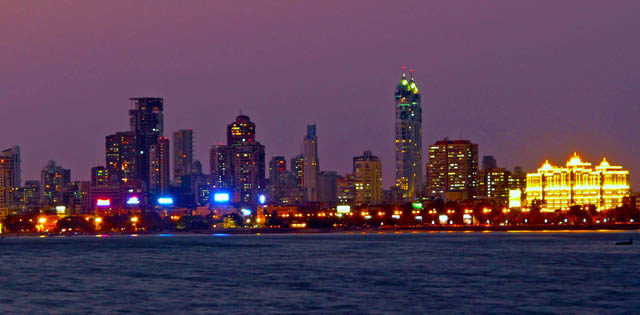Hardly a week passes without the news of some premium property sale in Mumbai where an industrialist or celebrity purchases a flat or building at a jaw-dropping price. Real estate consultancies routinely list Mumbai among the most expensive cities to buy real estate in, and this is all the more surprising because while one expects property in London, Monaco or Paris to be expensive, Mumbai, with its squalor, its slums and its creaking transportation system does not seem to quite fit in.

Image Courtesy : Wikipedia
As those of us who have studied Economics would know, price is determined by the interaction of demand and supply. The lower the supply, the higher the price. Similarly, the higher the demand, the higher the price.
So what are the factors lowering the supply of real estate and increasing its demand in Mumbai?
Geography is Mumbai’s biggest stumbling-block, Being an island city, and a length-wise one at that, Mumbai has very limited scope for expansion. Unlike Delhi, which expanded into Gurgaon and NOIDA to now be called NCR, the further one tries to stretch Mumbai, the more insufferable commuting becomes.
Government policy is another factor. Prices are driven by government-defined Ready reckoner rates which define not only minimum stamp duty but also provide a base price. In recent years, the rates in Mumbai have been hiked by upto 20%, which is substantial and more than the rest of the country.
Slumlands permeate much of Mumbai. With vast swathes of land occupied by slums, the supply of habitable land is further reduced. No slum rehabilitation policy has succeeded in dealing with this problem effectively.
Rent control also affects real estate supply, since a large number of tenants, especially in prime areas in the city, are able to live on rentals of less than five hundred rupees a month. Government regulation does not permit landlords to raise this rent, which means that the pressure on the real estate that is not rent-controlled to yield revenues is much higher.
At the same time, there are factors driving up demand for property in Mumbai as well.
First among these is high levels of Inward migration. Mumbai’s status as India’s commercial capital has been undisputed for decades. From white-collar jobs to menial work supporting the lifestyles of the rich, Mumbai provides employment to all. But this influx of people places pressure on the city to provide dwellings for them, dwellings that are in short supply
Far too much demand is also being created by a class of buyers known as ‘Investment buyers’ – those who have no intent to live in Mumbai but want to buy property there in the hope of making profits later. Typically non-resident Indians or those with large amounts of unaccounted (‘black’) money, these buyers further push up the already-high legitimate demand.
Lastly, Mumbai’s infrastructure makes it difficult for the population to spread evenly throughout the city. With only certain parts of the city capable of supporting business districts, the demand for proximity to the workplaces is tremendous. This raises property rates inordinately near these areas.
For all its flaws, Mumbai remains the most desirable city to live in, within India. No wonder then, that even with its indifference, poverty and over-crowding, it remains the place where more people are clamouring to live with every passing year. As long as the rest of India is unable to offer the same opportunities that this city does, we will continue to see overpriced real estate rule the roost in Mumbai.































